

"Fujara" manufacturing
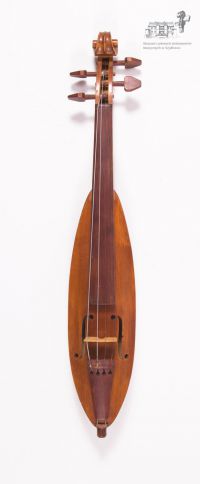
A Folk instrument - Zlobcoki
Chordophone called Zlobcoki is an old, folk instrument. Zlobcoki belong to a group of instruments called chordophones. Chordophones are one of the oldest musical instruments. Chordophone are divided into pulled chordophones, hammerhead chordophones and string chordophones. Instruments in which the sound source is one or more strings tensioned between two specified points.
Zlobcoki is an instrument with a very resonant sound, used in Carpathian Area (Podhale) before the spread of the violin; currently resumed in the folklore movement. Zlobcoki are hand made from wood and metal.
The films describes the history of described instruments - Zlobcoki, and gives the opportunity to listen to their sound in traditional folk music from the region of its origin – Carpathian Area (Podhale) in Poland.

A folk instrument from Poland - Bagpipe
Bagpipe called Dudy in Polish, is a woodwind musical instrument from the group of reed aerophones. They form a traditional band preserved to our times in the south-western part of Wielkopolska Area in Poland.
Materials: wood, leather, corner, metal, fabric
The film describes and demonstrates the instrument as well as the technique of making the instrument - Podhale Bagpipe . Thanks to the recording, you can also listen to their sound performed by folk artists.

Castanets technique - Spanish Castanets
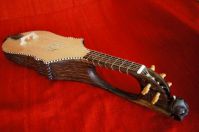
Crafting fine wood to discover its musical soul
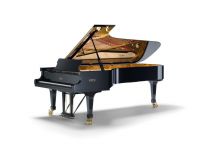
Fazioli promo: Inside a Dream
This video shows the ability of the piano artisans by the Fazioli Industry, based in Veneto, Italy. Every piano is handmade and require more than 30 months of work to be completed. The video shows the entire process of work, from the assembly of different pieces to the final step of painting and polishing the wood.
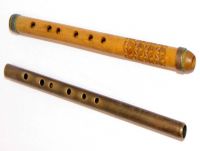
Handmade carved whistle
The whistle is a musical instrument made
of wood. All types of whistles have the shape of a cylindrical tube, with or
without holes.
The first whistle discovered on the
territory of Romania, in Moldova, dates back 20,000 years ago.
In the last century, many inhabitants
from the villages of Zarand Country (Arad, Alba and Hunedoara counties) were
specializing in various crafts, including whistles.
Today there are very few whistle
craftsmen who have inherited the father-to-son craftsmanship.
In this video, the last whistle master from the Dumbrava de Sus village, Ribita commune, shows us how to prepare and manufactured a whistle. He chooses the wood from the surrounding hills and can be of cherry tree plum tree, ash, hazelnut or willow.
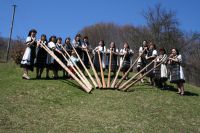
Handmade crafted tulnic – carving technique
The Tulnic is a musical instrument with
tubular shape, open at both ends, the musician blowing to the narrowest end.
The musical instrument has a length between 1,5 m and 3 m.
The tulnic is a archaic musical
instrument used in Apuseni Mountains for calls to battle, it signaled fires or
it simply played for cheer. The years passed by, the history changed and the
tulnic, just like so many other objects in the rural household has lost its
functionality.
Today, those who can still pass on the
secret of making tulnics to future generations are very few. Those who know how
to make them “sing” are also very few and they are generally women.
The wood from which the instrument is
made is called "fulgeris", a kind of spruce grown on mountains with a
fiber structure that allows for easy modeling.
The first step in making the tulnik consists of cleaning and longitudinally cutting from large diameters to small, in a prism shape, then dried at room temperature, away from the sun. Further, the wood is brought to the external form of the tulnic that we see, with the help of a iron tool and the last part of the process is the one where the juniper canes are used to tie the tulnic and then it can be decorated.

Manufacturing of Chaumy Drums
The video shows the manufacturing of a drum. The artisan works first the external structure of the drum, giving the right shape. Then, he uses the cords to tie the internal part of the drum.

Manufacturing of the violin "il cremonese" by Stefano Marzi
The video
shows the ancient art of lutist. The violin is made with spruce wood which is considered
the best one for instruments. The maple wood is used for the handle and the
bottom. For other parts of the violin, the artisans use willow wood or ebony.
The wood is worked with great ability and finally inlaid. The final step
consists in the painting and polishing of the instrument.

Rabel
The ‘rabel’ is a stringed instrument similar to the violin, with a variable number of strings, between 1 and 5. The sound is obtained by rubbing the strings with a bow while the instrument rests on the shoulder-chest, on the side, on the thigh of one leg or between the two legs. It can be played standing or sitting.
It was introduced into the Iberian Peninsula by the Arabs, extending and reaching its peak of popularity during the Middle Ages and the Renaissance, used by both troubadours and minstrels.
In its artisan construction, a piece of hollowed wood is used in customized ways to take different forms. There is no unique pattern. Usually it is made with more than one piece.
The main material used to make it is wood. Depending on the area, other materials are used for the covers, such as skins, tin or the wood itself. For the strings of the ‘rabel’, some animal guts can be used although today there are metallic strings that provide better sound and easier tuning. For the bow, a rod is traditionally sought, which can be bent, and for the ropes, horse hair is used. Currently, the mane can be replaced by very fine nylon that, once curled, makes very good rubbing.

Spanish classic guitar crafting technique
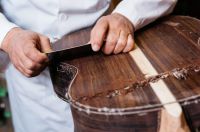
Spanish guitar production
Daniel Gil de Avalle's workshop specializes in the construction, assembly, maintenance, restoration and collection of stringed and plucked string instruments, located in an extraordinary setting: the heart of the historic Jewish quarter of Granada, the Realejo. Through the recovery and restoration of historical string instruments, the lutier Daniel Gil de Avalle contributes to the study and recovery of Spanish heritage and culture.
The process of construction of professional Spanish guitars and concert begins with the selection of high quality wood from different parts of the world: Palo Santo, Madagascar, Cypress, Fir, Cedar, Ebony, Maple, etc. The wood dries naturally between 10 and 30 years according to the model of the guitar, to ensure the maximum harmonic splendor of the guitar. During the construction process of these Spanish guitars, natural tails are used to provide the instrument with the necessary closing and tension. The guitar is varnished by hand, using Goma Laca so that the guitars acquire the maximum response given the elasticity of this varnish.

Traditional Cypriot Flut
This traditional Musical Instrument was used for traditional music and specifically the folklore music. It was easy to manufacture using local wood and it was accompanying shepperds in their everyday life. The instrument was used in fairs and events. It is a synonym to rural folclore music.

Wooden "koncovka" (folk heritage breathing musical instrument) production
Koncovka wooden instrument
The period of origin goes back
to 14-17. century, but currently the manufacture of it is typical near the river Morava. The inventor is not known, because
the shape and functionality changed by the development of this musical
instrument.

Yamaha Saxophones Factory Tour
Inside a Belgian Saxophones Factory, the video shows the manufacturing of saxophones. The saxophone was invented by the Belgian Adolphe Sax, from which the instrument took its name. The material used for the cladding of the saxophone is the brass. The saxophone is finally decorated and polished.
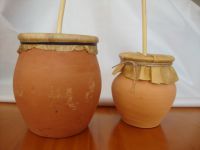
Zambomba
The zambomba is a musical instrument of friction. It consists of a hollow cylinder that can be of different materials (ceramic, cooked clay, wood, etc.) with one end closed with a patch, which is traversed through the centre with a rod made of wood or other materials. By rubbing the rod with both hands, the vibration produced is transmitted to the leather, producing a serious and peculiar sound.
The manufacturing process involves different artisans, such as potter, skinner and ‘zambombero’, who is to articulate the activity between them: he orders the potter in advance the pieces of clay, and buy the already dry skins from the skinner. The reeds for the rod are picked up directly in damp places. The ‘zambombero’ mounts all the pieces and tunes the instrument.
Its origin is in the flamenco neighbourhood parties that took place in Jerez, to accompany flamenco singing ‘cantes’. It was later enriched stylistically and musically in the following century, coinciding with the incorporation of the Andalusian carols ’villancicos’ to the flamenco repertoire.

